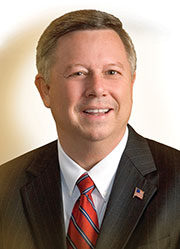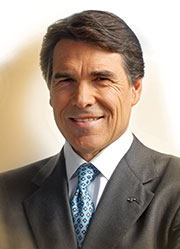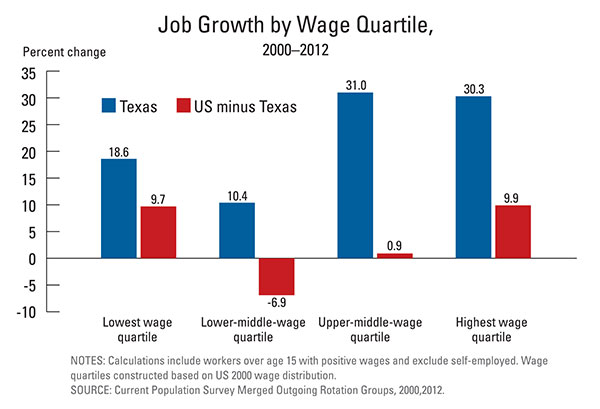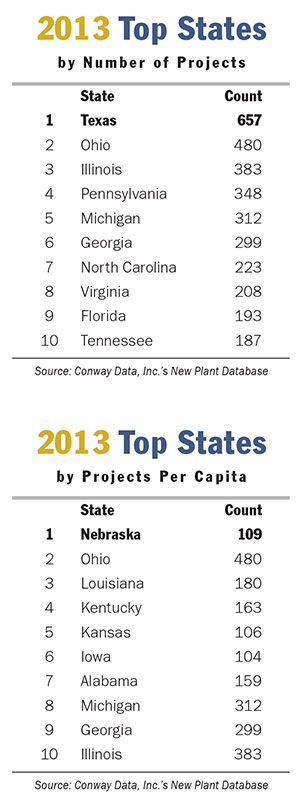Two governors have earned Governor’s Cup bragging rights for corporate facility project attraction in 2013.
No, there was not a tie for total qualifying projects. Texas wins again on that count, with 657. Ohio (480), Illinois (383), Pennsylvania (348) and Michigan (312) round out the top five. Congratulations, once again, Governor Perry. Rather, for the first time in its 26-year history, Site Selection is honoring a second state with the Governor’s Cup — specifically the state with the most qualifying projects per capita (per 1 million population). Qualifying projects meet one or more of these criteria: a minimum capital commercial investment of $1 million, 20,000 sq. ft. (1,860 sq. m.) or more of new construction or creation of 50 or more new jobs. Site Selection congratulates Nebraska Governor Dave Heineman on his state’s economic development success in 2013 and on being the first governor honored with a co-equal Governor’s Cup for corporate expansion activity per capita.
“I really appreciate this new methodology, because if it’s only based on the number of projects, the big states will always win,” says Gov. Heineman. “A per capita measure is fairer to small and medium-sized states in that they can feel like they’re making progress.” Nebraska finished 2013 with 109 projects. Runners-up on the per capita side are Ohio (480), Louisiana (180), Kentucky (163) and Kansas (106).
What’s going on in Nebraska, then, that resulted in such robust economic development activity?
“We are a right-to-work state with a strong work ethic among our employees,” Gov. Heineman tells Site Selection. “We are a low energy cost state, and we have a reasonable regulatory climate, which is very critical. We have very good public and private education systems, a low cost of living and an outstanding quality of life. All of those come into play when people are looking at your business climate.
“I don’t know if you can quantify this,” adds the governor. “But there is a very strong pro-business attitude in this state. We understand that if businesses are growing and prospering and making profits, they will pay their employees better, and they will grow jobs. Our business community is strong and respected, and I know that is not true in all states.”
Keep Business-Attraction Tools Sharp
The governor says he challenges his economic development organizations and the business community to always be cognizant of the fact that Nebraska competes globally and cannot be complacent. “Twenty-five years ago, we would change our incentives, and they would be good for two decades,” he points out. “Now, we have to look at our incentives, the tax structure — everything relative to the business environment — almost every year. Given technology and the mobility of the workforce, we have to stay on our competitive advantages and always be thinking about how to improve them.”
 “Our business community is strong and respected, and I know that is not true in all states.”
“Our business community is strong and respected, and I know that is not true in all states.”— Nebraska Gov. Dave Heineman
Nebraska Advantage is the Cornhusker State’s multi-tier incentives package. In 2012, the legislature passed a measure creating additional tier 2 benefits for large data center projects — specifically, a 10-year personal property tax exemption for those projects and a provision allowing taxpayers to sign a single agreement for a tier 2 large data center project and sequential tier 5 projects. Tier 2 incentive recipients must invest at least $200 million and create 30 or more new, full-time jobs.
The incentives are performance-based, and companies like that,” says Gov. Heineman. “We view these opportunities as partnerships for a lifetime. It’s not just about the ribbon-cutting or the ground breaking. We want to work with companies as they establish their business, and we’ll create a team to help them get through the permitting structure and other regulatory issues they have to deal with. We want businesses to have a good experience of dealing with our state, because they will tell others about that.”
The high tech, insurance and financial services, food processing, agribusiness and energy sectors all saw capital investment in Nebraska in 2013, as did other sectors. “In any successful state, it’s not one industry but a wide variety that contribute to that success. You have to compete literally across the board.”
The most significant projects by capital investment were a $200-million expansion by Travelers Indemnity in the Omaha metro; a new, $390-million facility for Prairie Breeze Wind Energy, LLC in Elgin; and Sutton Ethanol’s $188-million expansion in Sutton. Gov. Heineman points to a $10-million Yahoo expansion that will create 100 jobs and Fidelity’s new, $200-million data center announcement as among his state’s significant wins for the year. But no less important are critical air transport provider EagleMed’s expansion in Scottsbluff, and Teledyne Technologies’ plans to invest $12 million and hire 100 new employees in state capital Lincoln. Travelers’ 190,000-sq.-ft. (17.650-sq.-m.) data center joins several other in Sarpy County including Fidelity, Yahoo, Cabela’s and two Cosentry locations.

What Texas Does Right
Winning the Governor’s Cup using the traditional measure of total qualifying new and expanded projects is not a new experience for Gov. Rick Perry. Texas has won five times, including this year, since Gov. Perry assumed the governorship in December 2000. But it took a while, according to a look back at the Governor’s Cup results of a decade ago and more. Texas was not even among the Top 10 for 2001 new plant activity. It squeaked into 9th place for 2002 and jumped to 3rd place the following year. The governor’s first two Cups were for economic development success in 2004 and 2005. The next few years saw a battle for first place between Texas and Ohio, with the Buckeye State prevailing in 2006, 2007, 2008 and 2009 and Texas typically a close second. Texas reclaimed the prize in 2010, 2012 and now for 2013 activity.
 “With all due respect, Texas is crushing it.”
“With all due respect, Texas is crushing it.”— Texas Governor Rick Perry
Perry says states have to do four things right to be of interest to most corporate executives scouting new facility locations: taxes, regulation, the legal environment and a skilled workforce. “Businesses can figure out pretty quickly whether a state has done those right,” he tells Site Selection. “They need to work in any state.
“We have been doing this now for 12 years. It’s not a theory any more. It’s a fact. Companies nationally and internationally know what we have structured here in Texas,” he says, pointing to Argentine pipe manufacturer Tenaris’s $1.5-billion Bay City pipe mill announcement in February 2013. At the time, the company cited proximity to Houston, the world’s energy capital, and to Tenaris’s North American headquarters, favorable geography, operational logistics and availability of a skilled workforce. “Our new facility will complement our integrated global manufacturing network and work closely with our existing North American operations to further strengthen domestic production,” noted Paolo Rocca, the company’s chairman and CEO.
“The most profound statement about our favorable economic climate comes when companies like Tenaris make an investment of this size in our state,” added Gov. Perry. “That says that not only is Texas the best place to grow your business now, but they’re confident that we’ll remain that way moving forward.”

In addition to the four factors already mentioned, says Perry, three others are increasingly priorities for states, including Texas, to get right. “An adequate supply of water, affordable power and transportation infrastructure that allows products and citizens to move around safely and expeditiously are very important. We’ve been working on those last three for the last decade as well. In the competitive world we are in today, we had better play our best game every day. This experiment that we started in 2003 has proven to be very, very successful.”
 A hallmark of Gov. Perry’s business-attraction strategy more recently has been to travel to states (California, Illinois, Connecticut and Maryland, for example) to pitch Texas’ business climate to those states’ businesses. These forays always delivered headlines and publicity that helped make Texas’ case, which was rarely the intention of those writing the articles and headlines criticizing the trips.
A hallmark of Gov. Perry’s business-attraction strategy more recently has been to travel to states (California, Illinois, Connecticut and Maryland, for example) to pitch Texas’ business climate to those states’ businesses. These forays always delivered headlines and publicity that helped make Texas’ case, which was rarely the intention of those writing the articles and headlines criticizing the trips.
“One reason I go into these states is that I truly believe that if our country is going to recover economically and if we are going to be as strong as we can be and if Americans are going to be able to have access to good-paying jobs, it will come from states being free from one-size-fits-all policies emanating from Washington, D.C.,” says Gov. Perry. “That is always the core message. In fact I would elevate that message going forward as Washington seems to be less and less capable of functioning in any type of thoughtful way. It needs to get out of the healthcare business and the education business and the energy business and the infrastructure business and let the states do it. Quit strangling innovation in the states, because that’s where the real future of America is.”
One key to Texas’ success is its diverse economy. Active sectors include life sciences, logistics, energy, chemicals, business services, IT and headquarters (Los Angeles-based Occidental Petroleum announced February 14th that it will relocate its headquarters to Houston). The oil and gas sector accounts for about the same percentage of Texas gross state product as it did in 1984. “That means the rest of the economy grew at a substantial rate,” says the governor.
Texas won another bragging right in February when TechAmerica Foundation reported that it surpassed California in global technology exports in 2012 (see p. 95), a milestone that is particularly sweet to Gov. Perry.
“California liked to say that Texas can have all those low-wage jobs,” he says. “But look at [Dallas Federal Reserve President and CEO] Richard Fisher’s observation that between 2000 and 2012, in job growth percentage change by wage quartile, we lead the nation in every quartile [see chart, page 96]. With all due respect, Texas is crushing it.” Analysis like that tells the real story, says Perry, adding that project data behind Site Selection’s Governor’s Cup and other rankings back that up. “This is not an anomaly or a theory. It’s fact.
“This is not about me running around the country saying, ‘Look what Rick Perry has done.’ I hope people will take away from this the fact that it can happen in their state with the right leadership. The results are the story — the tech exports, the job creation, the quality of life that comes from that. And it needs to be the story all over the country.”
